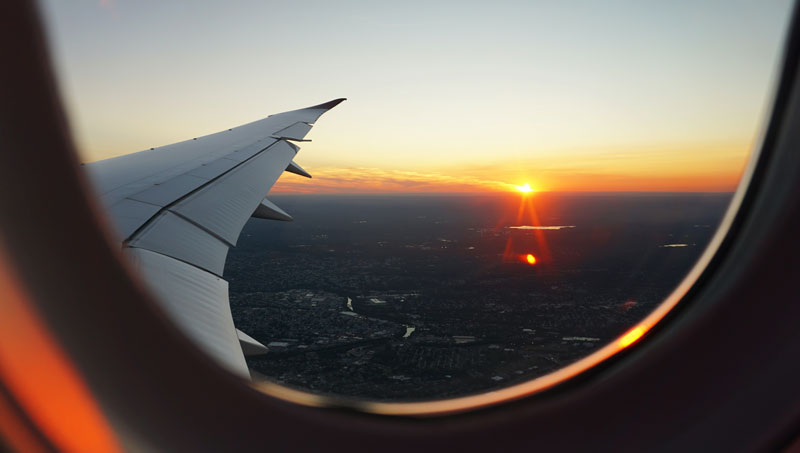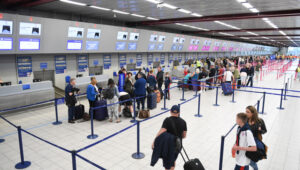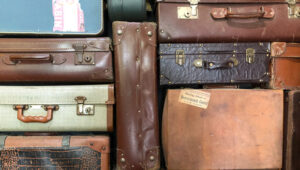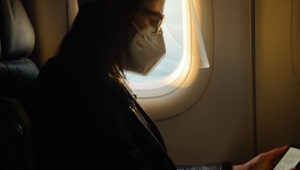How air travel dramatically changed how many of us are roaming the world
In the past 70 years, the prevalence of affordable air travel has led to a seemingly smaller globe as people of all ages have the opportunity to travel wherever they might wish. Retirees especially, who may have never been abroad until well into adulthood, are discovering the world, acquiring new experiences and building memories. Thanks to the complex network of airline services between countries and the affordable prices of today’s flights, older people are finding it’s never too late to visit any number of wonderful destinations, and they’re making the most of it.
Photo by Phil Mosley on Unsplash
However, in the 21st century, air travel is not without its challenges. Fractious children, frayed tempers and exhausted parents are scenarios all too frequently to be found at airports around the world. Delayed and cancelled flights, industrial action, over booking and seemingly interminable queues all serve to frustrate the would-be traveller and then there are the security checks, further compounded by body searches and confiscations of any items – from shower gel to nail scissors – deemed a potential danger. Overly crowded departure lounges serve only to aggravate the situation. Air travel today is certainly not the relaxed and glamorous pastime it once was and recent events occurring as a result of the coronavirus pandemic have highlighted some of the issues surrounding mass international travel.
Air travel takes off
The first ever air passenger was a certain Abram C Pheil, the former mayor of St Petersburg, Florida, who, in 1914, paid $400 (the equivalent of $9,300 today) to travel the 23 miles to Tampa on a seaplane piloted by Tony Jannus, a journey that took 20 minutes on the 60mph aircraft.
Although this was seen as a major breakthrough in public transport, initially air passengers found themselves sharing their flights with mail, or rather, strictly speaking, the mail shared its flight with the passengers as passengers were a secondary consideration on these journeys. Due to the relatively unsophisticated planes of the times, flying was a bumpy and noisy affair, although, fortunately, passengers were well catered for. Fine wine and food, and in some cases simple in-flight entertainment in the form of radio broadcasts and films shown on a single screen, made the uncomfortable trip a little more bearable.
Nevertheless, despite the discomfort, the popularity of flying was growing rapidly and, in the US, within the four years from 1930 to 1934, the number of airline passengers expanded from 6,000 to 450,000 per year and by 1938, the figure was 1.2 million. However, despite the huge rise in passenger numbers, the cost of flights meant this form of transport was still only available to the very rich, or to Hollywood stars and politicians.
The glamour – and danger – of airships
Around this time, airships also made their appearance, such as the Graf Zeppelin and the more modern Hindenburg and, for a few years, airship travel became popular with those who could afford the high fares. Airships had the advantage of being able to travel far longer distances than planes, which were limited by their low fuel capacities, and they offered a truly luxurious experience, with their beautiful interior décor, extravagant menus and extensive wine lists.
Unfortunately, these early airships had one fatal flaw. The hydrogen that was used inside the structure to maintain buoyancy was, in essence, an accident that was waiting to happen. Following the Hindenburg disaster in 1937, in which 35 people died in an apparent explosion of the highly inflammable gas, the fate of airship travel was sealed. It was clear there was no long-term future in the idea and attention turned once more back to the aeroplane.
Photo by Nick Fewings on Unsplash
The postwar travel boom
Of course, during the Second World War, commercial aviation took a break but once hostilities had ended, adventurous people with money to spare rather liked the idea of seeing more of the world, and they wanted to do it much more quickly than by using the only other form of international transport at that time which was travel by ship.
The 1950s saw air travel grow rapidly, especially when the first jets, such as the Boeing 707, took to the skies, but flying was still the preserve of the wealthy, or for the businessman whose firm could pick up the tab. In the US, the vastness of the country made air travel an attractive proposition when it came to internal flights and aeroplanes began to offer a much more efficient means of transportation when compared with trains and buses, or even cars.
Through the 1950s and 1960s, the exclusivity of air travel made for a very upmarket experience. Unlike today when travellers dress casually in comfortable clothes, air passengers of the mid-20th century dressed for the occasion. Usual attire would be suits for men, while for women it was smart dresses and jackets (probably worn with gloves) and hats, the latter item to be removed once on board.
Similarly, pilots (always male) dressed in pseudo military-style uniforms and attractive air hostesses wore elegant and fashionable clothing, all of which added to the prestige of the airlines. For those working on the routes, particularly long-haul, the perks and glamour of travelling to exotic locations more than made up for the long hours. These jobs were seen as the ultimate in glamour, combining as they did the excitement of travelling to exotic locations with the opportunity to meet interesting and/or famous people.
A taste of luxury
Airline food also became a grand affair. In the 1920s, onboard meals were often cold dishes with a luxurious touch, such as lobster, oysters or foie gras, but by the 1950s, diners expected hot meals to be served – and they wanted three courses with silver service. Dishes such as beef in red wine, salmon en croute and exotic local delicacies became the norm, all washed down with copious quantities of free alcohol, including champagne.
Photo by Alexander Naglestad on Unsplash
In fact, so important was the food that airlines vied with one another, each trying to offer the most sophisticated and visually exciting menu. Furthermore, throughout the flight, attentive stewards and stewardesses ensured that, like pampered guests, passengers wanted for nothing. Dubbed the ‘golden age of air travel’, flying during these decades was as much about the experience as it was of quickly getting from A to B, but all that was to change in the 1970s.
Affordability for all
As more flights became available, so fare prices dropped and suddenly air travel was no longer the preserve of those with the cash to splash. Ordinary people – from office and factory workers to young people, from newlyweds to families – were wanting their piece of the sun, preferably in Spain, France or Portugal, and airlines started to cater for this new type of customer. Package holidays meant that holidaymakers no longer had to worry about buying their air ticket and booking their hotel, as the tour operators would take care of everything, and thanks to their huge buying power, these companies could demand the most competitive rates, which they could then pass on to their customers.
The deal was finally sealed in 1977 when Freddie Laker started his ‘no frills’ airline, Laker Airways, that paved the way for Ryanair, Easyjet and similar airlines in the coming decades. Ironically, Laker Airways was also to set the scene for future disgruntled passengers when the company’s collapse in 1982 led to 6,000 travellers being stranded in airports around the world, a drama that has played out similarly on numerous occasions since.
While onboard meals and drinks were still included in the fare on most flights during the 1980s and 1990s, cost-cutting became ever more prevalent and the growth of budget airlines, despite the demise of Laker, led to pressure to reduce both fares and level of service throughout the industry in all but the top-end sectors, such as first class, business class and that ultimate in luxury flight, Concorde. Meals now had to be purchased and, in some cases, luggage for the hold paid for separately, the idea being to offer a range of payment options to the passenger depending upon their budget. Naturally, none of this was of any relevance to the very wealthy, many of whom opted to travel by private jet, on board which they could enjoy luxury somewhat akin to a flying hotel.
An era of change
Never before had so much air transport been offered to the general public. Catching a flight became no more unusual than taking a train or a bus, but then on 11th September 2001, it was all to change for ever with the terrorist attack on the World Trade Center in New York. Suddenly, rushing to the airport at the last minute to catch a flight was no longer an option as tight security measures demanded an arrival at the airport of at least two hours prior to the flight departure to allow sufficient time for passing through the various checks. Although hijacking had been a problem in the past, especially during the 1970s, 9/11 was a tipping point that acknowledged terrorism as a real threat to the safety of air travel.
Photo by Camila Perez on Unsplash
Now in 2020, the vulnerability of the airline industry and mass travel has come very much to the fore. The coronavirus pandemic has led to huge restrictions that have left air companies struggling to make ends meet, resulting in job losses and withdrawal of routes and services. Furthermore, with fewer planes flying during a ‘global’ lockdown, concerns over the excessive air pollution and, in some areas, noise emitted by aircraft have led to questions as to whether we really need to travel as frequently as we do.
Meanwhile the super-wealthy are looking towards the next big adventure with the first tickets for spacecraft travel already having been sold ahead of any concrete plans for trips to take place. Perhaps we now stand on the edge of a whole new era – the golden age of space travel. The question is, where will it take us?
By Halima Crabtree, LifeBook editor.
Main photo by Eva Darron on Unsplash





